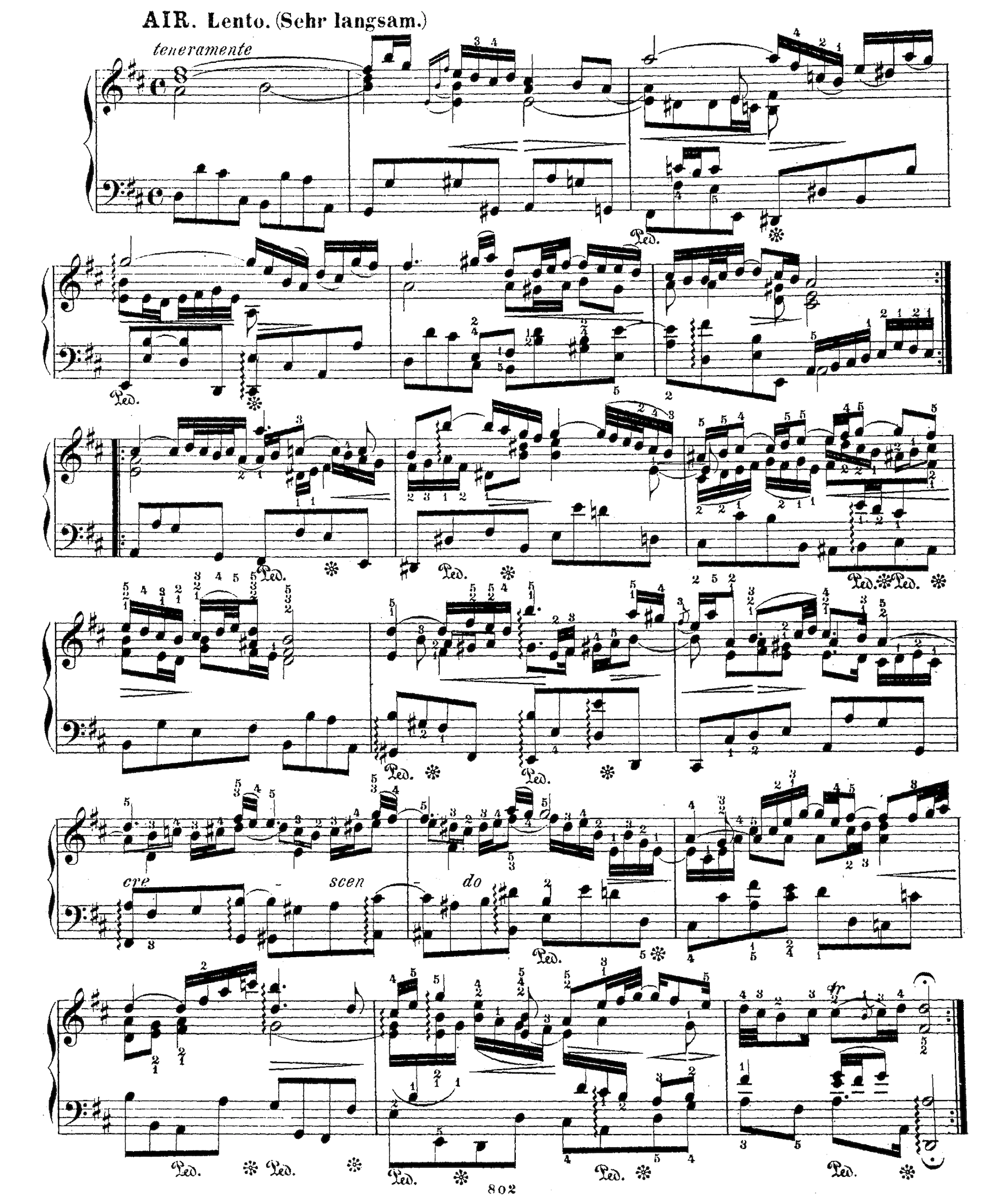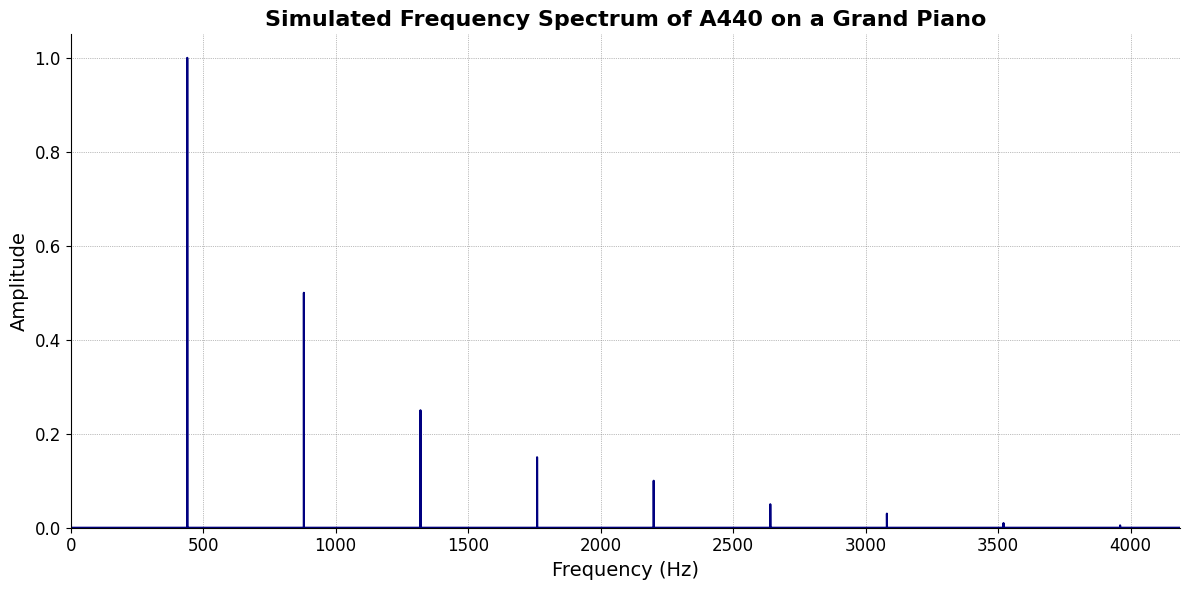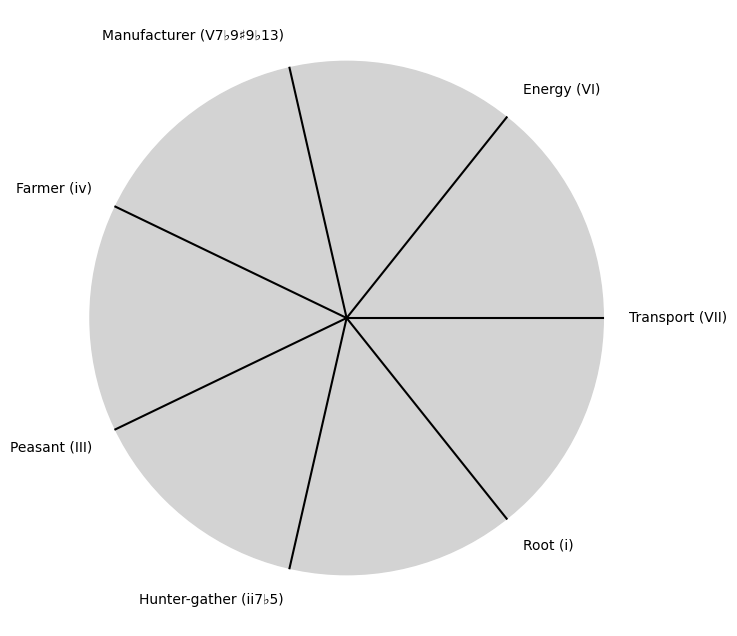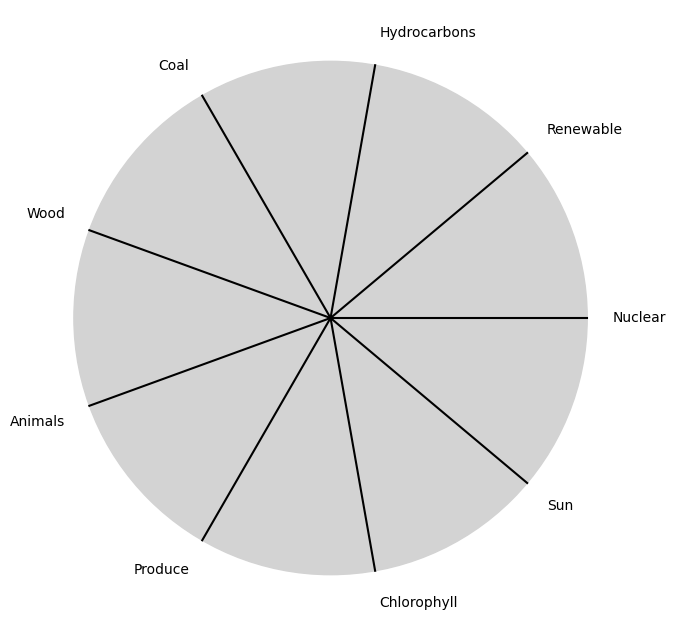Aficionado#
From the point of view of form, the
archetype of all the arts is the art of the musician - Oscar Wilde
1. Archetype#

BWV 1068 II. It’s in binary form with Parts A & B, which I further divide into functional parts A1, A2, A3 & B1, B2. Part A1 in the Ionian D maj evokes “Paradiso” (bars 1-2), in pure unthreatened diatonic delight. Part A2 has a few chromaticisms (bars 3-4: iidim7-V7-i) leading to a flirtation with Dorian Emin. This Emin launches a ii-V7-I into the the Mixolydian A maj (bars: 4-5). Part A3 is back to Ionian D maj theme bars (5-6), but veering off from Paradise to get “Lost”.43 Part B1 evokes “Inferno” with stepwise descent from the Mixolydian A maj until a tritone is reached at D# (the third of a dom7) and resolved to the Dorian E min (iidim7-V7-i at bars: 7-8).51 This is repeated one more time to A# and resolved to the Aeolian B min (ii-V7-i at bars 9-10). Another descent, but this time a purely diatonic one via the perfect 5th, from B min to C#minor resolves in an E7 cadence to A (ii-V7-I at bars: 10-12). We sense and feel something different: we are set for “Purgatorio”,52 the unmistakable chromatic climb from Mixolydian A towards the Ionian heavens in D (I/III-IV-II/#IV-V-III/#V-vi). (Inspired by the opening sequence of S12E7 Parts Unknown: Lower East Side)#
ii#
Phonetics
Temperament
Rhythm
V7#
Modes
i#
Chords
Blood
2. Film#
Genesis#
Inherited. Formulae of tension (bad marriage) & release (church music)
Added. Gun-brandishing, bible-quoting, auteur-in-drag
Overcome. Not by means of resistance training, but deliverance often through the church
Exodus#
Characters. Full range of characters including protagonists, antagonist, props, enablers, etc
Samuel#
Prophets. The characters he creates don’t have individually compelling arcs that subsume many of the
parametersof lifeMonarchs. Home-cuming is contrived and doesn’t throw us a bone to chew on for some time
3. TV#
1. f(t)
\
2. S(t) -> 4. y:h'(t)=0;t(X'X)X'Y -> 5. b -> 6. SV'
/
3. h(t)

No Reservations: Tuscany. The trip of a cook inside the hell of himself - Vincenzo. In John Adams letter to Abigail concerning the “three generation” process of making an artist or seeker of leisure, we can reconceptualize it as a ii-V7-I chord progression. One ancestor departs from the homeland and finds manual work (garbage collection for Kardashians). Their struggles in a new adoptive home yield a triumph: a professional second generation (trial lawyer for Kardashians). The final generation has seen no struggle and the family has “returned” to the idealized paradise they would have wanted at their original home but found elsewhere. It’s in this light that you should read the letter to Abigail 53*#
Departure#
Heritage
Emigration
Menial-work
Struggle#
Professional work
Return#
Leisure seeking
Nihilism
4. History#
1. Pessimism
\
2. Beyond Good & Evil -> 4. Dionysian -> 5. Science -> 6. Morality
/
3. Robustness

The School of Athens. ii. Inherited constraints from the Greeks of antiquity who constrained themselves to reason rather than passions and divinity. Also borrowed a new one from Leonardo Da Vinci, to represent the three-dimentional reality being depicted. V7 Additional fetters Raphael di Urbino introduced include that dramatic juxtraposition of the different realms of inquiry within the same setting, but clustered in different parts. But placed the generalists at the very center. He restrained himself to perfect imitation of the physical form & the nuanced language in body posture & engagement with others. i. Overcoming with ease all these inherited and added fetters might seem like the work of a genius. But this actually took Raphael 15 years, with the support of his large and gifted team. So he conceived of it as a Maestro, but “conducted” the orchestra who actually delivered the performance#
\(\mu\) Base-case#
Senses: Curated
Show code cell source
import numpy as np
import matplotlib.pyplot as plt
# Parameters
sample_rate = 44100 # Hz
duration = 20.0 # seconds
A4_freq = 440.0 # Hz
# Time array
t = np.linspace(0, duration, int(sample_rate * duration), endpoint=False)
# Fundamental frequency (A4)
signal = np.sin(2 * np.pi * A4_freq * t)
# Adding overtones (harmonics)
harmonics = [2, 3, 4, 5, 6, 7, 8, 9] # First few harmonics
amplitudes = [0.5, 0.25, 0.15, 0.1, 0.05, 0.03, 0.01, 0.005] # Amplitudes for each harmonic
for i, harmonic in enumerate(harmonics):
signal += amplitudes[i] * np.sin(2 * np.pi * A4_freq * harmonic * t)
# Perform FFT (Fast Fourier Transform)
N = len(signal)
yf = np.fft.fft(signal)
xf = np.fft.fftfreq(N, 1 / sample_rate)
# Plot the frequency spectrum
plt.figure(figsize=(12, 6))
plt.plot(xf[:N//2], 2.0/N * np.abs(yf[:N//2]), color='navy', lw=1.5)
# Aesthetics improvements
plt.title('Simulated Frequency Spectrum of A440 on a Grand Piano', fontsize=16, weight='bold')
plt.xlabel('Frequency (Hz)', fontsize=14)
plt.ylabel('Amplitude', fontsize=14)
plt.xlim(0, 4186) # Limit to the highest frequency on a piano (C8)
plt.ylim(0, None)
# Remove top and right spines
plt.gca().spines['top'].set_visible(False)
plt.gca().spines['right'].set_visible(False)
# Customize ticks
plt.xticks(fontsize=12)
plt.yticks(fontsize=12)
# Light grid
plt.grid(color='grey', linestyle=':', linewidth=0.5)
# Show the plot
plt.tight_layout()
plt.show()
Show code cell output

Memory: Luxury
Emotions: Numbed
\(\sigma\) Varcov-matrix#
Evolution: Society 17
Show code cell source
import matplotlib.pyplot as plt
import numpy as np
# Clock settings; f(t) random disturbances making "paradise lost"
clock_face_radius = 1.0
number_of_ticks = 7
tick_labels = [
"Root (i)",
"Hunter-gather (ii7♭5)", "Peasant (III)", "Farmer (iv)", "Manufacturer (V7♭9♯9♭13)",
"Energy (VI)", "Transport (VII)"
]
# Calculate the angles for each tick (in radians)
angles = np.linspace(0, 2 * np.pi, number_of_ticks, endpoint=False)
# Inverting the order to make it counterclockwise
angles = angles[::-1]
# Create figure and axis
fig, ax = plt.subplots(figsize=(8, 8))
ax.set_xlim(-1.2, 1.2)
ax.set_ylim(-1.2, 1.2)
ax.set_aspect('equal')
# Draw the clock face
clock_face = plt.Circle((0, 0), clock_face_radius, color='lightgrey', fill=True)
ax.add_patch(clock_face)
# Draw the ticks and labels
for angle, label in zip(angles, tick_labels):
x = clock_face_radius * np.cos(angle)
y = clock_face_radius * np.sin(angle)
# Draw the tick
ax.plot([0, x], [0, y], color='black')
# Positioning the labels slightly outside the clock face
label_x = 1.1 * clock_face_radius * np.cos(angle)
label_y = 1.1 * clock_face_radius * np.sin(angle)
# Adjusting label alignment based on its position
ha = 'center'
va = 'center'
if np.cos(angle) > 0:
ha = 'left'
elif np.cos(angle) < 0:
ha = 'right'
if np.sin(angle) > 0:
va = 'bottom'
elif np.sin(angle) < 0:
va = 'top'
ax.text(label_x, label_y, label, horizontalalignment=ha, verticalalignment=va, fontsize=10)
# Remove axes
ax.axis('off')
# Show the plot
plt.show()
Show code cell output

\(\%\) Precision#
Needs: God-man-ai
Show code cell source
import matplotlib.pyplot as plt
import numpy as np
# Clock settings; f(t) random disturbances making "paradise lost"
clock_face_radius = 1.0
number_of_ticks = 9
tick_labels = [
"Sun", "Chlorophyll", "Produce", "Animals",
"Wood", "Coal", "Hydrocarbons", "Renewable", "Nuclear"
]
# Calculate the angles for each tick (in radians)
angles = np.linspace(0, 2 * np.pi, number_of_ticks, endpoint=False)
# Inverting the order to make it counterclockwise
angles = angles[::-1]
# Create figure and axis
fig, ax = plt.subplots(figsize=(8, 8))
ax.set_xlim(-1.2, 1.2)
ax.set_ylim(-1.2, 1.2)
ax.set_aspect('equal')
# Draw the clock face
clock_face = plt.Circle((0, 0), clock_face_radius, color='lightgrey', fill=True)
ax.add_patch(clock_face)
# Draw the ticks and labels
for angle, label in zip(angles, tick_labels):
x = clock_face_radius * np.cos(angle)
y = clock_face_radius * np.sin(angle)
# Draw the tick
ax.plot([0, x], [0, y], color='black')
# Positioning the labels slightly outside the clock face
label_x = 1.1 * clock_face_radius * np.cos(angle)
label_y = 1.1 * clock_face_radius * np.sin(angle)
# Adjusting label alignment based on its position
ha = 'center'
va = 'center'
if np.cos(angle) > 0:
ha = 'left'
elif np.cos(angle) < 0:
ha = 'right'
if np.sin(angle) > 0:
va = 'bottom'
elif np.sin(angle) < 0:
va = 'top'
ax.text(label_x, label_y, label, horizontalalignment=ha, verticalalignment=va, fontsize=10)
# Remove axes
ax.axis('off')
# Show the plot
plt.show()
Show code cell output

Utility: modal-interchange-nondiminishing
Show code cell source
import numpy as np
import matplotlib.pyplot as plt
# Define the total utility function U(Q)
def total_utility(Q):
return 100 * np.log(Q + 1) # Logarithmic utility function for illustration
# Define the marginal utility function MU(Q)
def marginal_utility(Q):
return 100 / (Q + 1) # Derivative of the total utility function
# Generate data
Q = np.linspace(1, 100, 500) # Quantity range from 1 to 100
U = total_utility(Q)
MU = marginal_utility(Q)
# Plotting
plt.figure(figsize=(14, 7))
# Plot Total Utility
plt.subplot(1, 2, 1)
plt.plot(Q, U, label=r'Total Utility $U(Q) = 100 \log(Q + 1)$', color='blue')
plt.title('Total Utility')
plt.xlabel('Quantity (Q)')
plt.ylabel('Total Utility (U)')
plt.legend()
plt.grid(True)
# Plot Marginal Utility
plt.subplot(1, 2, 2)
plt.plot(Q, MU, label=r'Marginal Utility $MU(Q) = \frac{dU(Q)}{dQ} = \frac{100}{Q + 1}$', color='red')
plt.title('Marginal Utility')
plt.xlabel('Quantity (Q)')
plt.ylabel('Marginal Utility (MU)')
plt.legend()
plt.grid(True)
# Adding some calculus notation and Greek symbols
plt.figtext(0.5, 0.02, r"$MU(Q) = \frac{dU(Q)}{dQ} = \lim_{\Delta Q \to 0} \frac{U(Q + \Delta Q) - U(Q)}{\Delta Q}$", ha="center", fontsize=12)
plt.tight_layout()
plt.show()
Show code cell output


Essay in my \(R^3 class\). At the end of the drama THE TRUTH — which has been overlooked, disregarded, scorned, and denied — prevails. And that is how we know the Drama is done.” Some scientists may be sloppy because they are — like all humans — interested in ordering the world rather than in rigorously demonstrating a truth#
5. Beverage#
Fermentation is simple. Little bugs eating sugar, pissing alcohol, farting carbon dioxide 17

Belgians: Our ii-V7-i allusion to the dramatic arc fits here neatly. Our inherited constraints relate typically to the starchy food that has been available to our ancestors for geographical and econological reasons. Perhaps our added fetters are the yeasts we choose to harness or exclude from the brewing process. And we perfect the very elaborate process to give a sense of ease in overcoming the biochemical & gastronomical barriers along. To this end we may throw in some hops and other ingredients, a sort of node to “surplas” and excess. That said, it is in seeking new constraints and fetters that our efforts will never fall prey to “diminshing returns”. We may find fetters in our ancestry, our own creativity, or by borrowing ideas from neighbors near and far. Witness, here, Westmalle Dubbel, \(7\) %, Duvel, \(8.5\) %, Truth, \(8.7\) %, Westmalle Tripel, \(9.5\) %, and St. Bernardus Abt 12, \(10\) %. The parameters emphasized by each beer vary from malt, to yeast, to hops & more#
ii#
Phonetics
Temperament
Rhythm
V7#
Modes
i#
Chords
Blood
6. Music#

Michael Tilson Thomas: TED Talk: Music and emotion through time has parallels with Dante’s Allegory. He used a more syntactical “what” and “how” question he inherited from his dad. I prefer my ii-V7-i#
ii#
Phonetics
Temperament
Rhythm
V7#
Modes
i#
Chords
Blood
7. Italia#
Sitting in the gardens
A fountain dribbling in the background
A vista of unparalleled loveliness in every direction
The taste of soft blue rippled cheese in my mouth
The sum-total of the grass the sheep ate
The generations of airborne cultures
History, magic and artistry:
I found myself overcome with regrets
ii Primo#
Hell-Geothermal/Aperitivo, AntipastoPrimo
Secondo, Contorno
V7 Dolce#
Purgatory-Mountain/Insalata, Formaggi e Frutta, Dolce, Caffé, Digestivo
i Inferno#
Goals-Solar/Dante’s allegory is the theme of S3E10: Tuscany 54The structure of Dante’s Inferno: Hell, Purgatory, Goals is truly from our collective unconscious
8. Bourdain#
1. f(t)
\
2. S(t) -> 4. y:h'(t)=0;t(X'X).X'Y -> 5. b -> 6. SV'
/
3. h(t)

Anthony Bourdain’s TV Career. He changed from a food network, to a travel network, and ultimately a news network. This emergence from inferno (ii), to urgatorio (V7), with eyes on paradiso (i) is out of the spirit of music: with MQ-TEA. In Tuscany we are fussing about Dante Allegheri’s allegory (No boundaries), in Tokyo we are analyzing the value of Judo to a sushi chef (Parts Unknown), in Brasil we are hiting at the intermodal factors that give the footballing nation its distinction as the most decorated in the world.#
ii: Inherited Fetters (+ Self-Imposed) 1, 2, 3#
Summary: ii. departure - V7. struggle - i. return. This is drawn from the interchange of modes, qualities, and relatives in the context of Aeolian i/III that is always in the 1st inversion. Chopin inherited this from the 2nd, 3rd, and 4th opening bars of “Lacrimosa” (Aeolian with a Phrygian element much later).
A bii chord from the Phrygian mode may be inserted. Its qualities may then be varied: bII7 - bII6 - biiø7 - biidim7. This chord non-progression might come after the Aeolian iim7b5 in a return to home. A return to a false i via an Ionian I7 lends seamless voice leading from bii7-bii°7-biiø7-I7. And then we return to the Aeolian root as follows: I7 - idim7 - im7. So thats a quick dash across three modes!
My inheritance here from Chopin, my ancestor, is one of “chains”: how daintily he dances in the chains at bii. He again does so later at V7b9 (tonic E minor) - V7 - vm7 - vdim7 (relative G Major), and finally in a very deceptive cadence on the home melody (E) at Vb9 - Vb97 - V7sus - V7sus13 - V7susb13 - Vb97/Vb7. Such chord non-progression is akin to a dam holding back a river from its destiny at the estuary. Once the sluice gates open, my banks will overflow. Mozart gave to Chopin, Chopin gave to me, and thus it is my duty to perform acts of charity for the next generation.
V7: Dancing in Chains 4#
Inherited “chains” become an arena for demonstrating resilience and creativity, much like complex chord progressions that defy straightforward resolution. If I’m to play the hero in my lifetime, it is because others have placed hope in me, given that “my cup runneth over.” They are right because to them it seems that I effortlessly dance in these inherited and self-imposed fetters and obstacle courses during my odyssey.
i: Born to Etiquette 5, 6#
Our premise in discussing these matters is that a mere ii-V7-i progression without the transformations (insertions and deletions) would be a bland moral tale of faith.
The aesthetic accomplishment is in overcoming a seemingly endless and randomly generated number of barriers, and worthy adversaries, with grace and poise. This is much more compelling than the contrived, tidy ii-V7-i. With so many transformations, the overarching ii-V7-i can’t even be perceived and so it never seems contrived.
9. Modes#
Temperament#
Modal interchange, also known as modal mixture, allows composers to borrow chords from parallel modes, creating rich and evocative harmonies while staying grounded in traditional tonal frameworks. This technique enhances the emotional palette, bringing depth and unexpected colors to music.
Scales#
Reflecting on Anthony Bourdain in this context is fascinating. Bourdain’s storytelling often juxtaposed familiar culinary traditions with unexpected cultural insights, much like how modal interchange blends familiar harmonic structures with surprising twists. His ability to evoke profound emotions and convey deep connections through his journeys mirrors the evocative power of modal interchange in music.
MQ-TEA#
Bourdain's episodes, such as the one in Tuscany that employed Dante's allegory and the one in Tokyo, where delved into the origins of Seinen manga, resonate with the idea of exploring new dimensions within familiar contexts. Just as modal interchange enriches a piece of music, Bourdain’s narratives enriched our understanding of cultures and the human experience. His approach was a masterful blend of tradition and innovation, much like the compelling harmonies created through modal interchange.
10 Uncertainty#
1. f(t)
\
2. S(t) -> 4. y:h'(t)=0;t(X'X).X'Y -> 5. b -> 6. SV'
/
3. h(t)

No Reservations. The phrase “I’m certain of nothing” was tattooed on Anthony Bourdain’s right arm early in his television career. This statement encapsulates the ethos Bourdain carried throughout his life—a deep awareness of the uncertainties and complexities of the world. It reflected his approach to travel, food, and culture, where he remained open to new experiences and perspectives, never claiming absolute knowledge or superiority. The tattoo became symbolic of Bourdain’s relentless curiosity and his willingness to embrace the unknown, both in his personal journey and in the stories he sought to tell on screen.#
ii: Inherited fetters: archetypes, \(\mu\)#
\(f(t)\) Life randomly throws stuff at you as if from a density function (
partsof which areunknown)\(S(t)\) TV is a
cumulative medium, its serialized, a resonant emotion in one episode has been earned over earlier ones\(h(t)\) Film caters to instantaneious gratification and has major constraints, but also a solution for the impatient
V7 Dancing in chains: stereotypes, \(\sigma\)#
\((X'X)^T \cdot X'Y\) Variation on inherited themes from the collective unconscious
i Born to etiquette: phenotypes, \(\%\)#
\(\beta\) Isolated parameters describe subgroups and stereotypes
\(SV'\) But the summation of the parameter values & weights within an individual: now that reveals phenotype
11. Draw Blood#

Parts Unknown: Bahia, Brazil S3E8. Oh yeah, now we’re getting to the claw. Look at that, let’s poke it out of there. Oh yeah, push it through that little node of goodness, like a celestial nipple. When people started demanding boneless stuff, like chicken without a bone, or crab meat without the actual crab, or lazy lobster, that was the beginning of the erosion of our society as we know it. If you’re not willing to work for a payoff like this, how do you expect us to, like, fight al-Qaeda if you can’t suck the meat out of a crab? A character builder, and delicious.-Parts Unknown, Brasil#
ii Inherit - Troy/Genesis#
This sentiment taps into a deeper cultural critique \(f(t)\)—one that laments the loss of appreciation for effort, patience, and the rewards that come from perseverance. When you talk about the shift toward “boneless” or pre-prepared foods, it’s not just about convenience; it’s a symbol of a broader societal trend toward instant gratification \(y:h'(t)=0\) and a reluctance to engage with the processes that require time, effort, and, frankly, a bit of grit \(S(t)\).
Picking apart a crab or wrestling (V7) with a lobster is indeed a kind of ritual—a tactile, almost primal (ii)experience that connects you to your food (i) in a way that a neatly packaged fillet never can \((X'X)^T \cdot X'Y\).
It’s a reminder that some of the best things in life require effort. This isn’t just about the literal food on your plate but serves as a metaphor for broader aspects of life. If you can’t be bothered to crack a crab shell, what does that say about your willingness to engage with the more challenging aspects of life?
V7 Add - Odyssey/Exodus#
It’s a critique of a culture that’s increasingly focused on convenience at the expense of experience. The “lazy lobster” is just one example, but it’s emblematic of a larger shift where the pursuit of ease has overtaken the appreciation for the journey. Whether it’s in food, relationships, work, or even in the way we consume information, the emphasis on quick, easy, and ready-made experiences undermines the character-building that comes from struggle and the satisfaction of earning something through effort.
i Overcome - Ithaka/Canaan#
And yes, while it’s a bit tongue-in-cheek to connect this with something as serious as fighting al-Qaeda, the underlying point holds: If we lose the capacity to work for our rewards, to endure discomfort, and to engage fully with the process \(\beta\), what does that say about our resilience as a society? The decline of patience, perseverance, and the willingness to engage with difficulty can indeed be seen as symptomatic of a broader societal erosion.
So, in that sense, the crab claw isn’t just a piece of meat—it’s a litmus test for something much deeper. If you’re not willing to work for that little nugget of goodness, what else are you not willing to work for \(SV'\)?
12. Reversed#

Dionysus, Bacchus, French, Cajun, Mardis Gras. This table highlights the evolution of French aristocratic traditions from the Renaissance through to modern times, showing how they influenced both Mardi Gras and cultural representations like The Rules of the Game. Life, even for the aristocrats is departure from the ideal: ii. Struggles, old & new create tension: V7. Rather than overcome these troubles, create an annual or seasonal occassion where you “dance in the chains” by induced frenzy i#
Ash Wednesday#
Inherited
Added
Overcome
Entire Year#
MQ-TEA
Fat Tuesday#
Frenzy
Masks
13. Renoir#
ii. Restraint: Ash Wednesday#
Aristocrats (Renoir’s Rules of the Game)
Catholic: Ex Favilla, Dies Irae, Penitence
Dancing in chains 3
V7. Tension: Entire Year#
Every person, across all time, and geographic locale
i. Indulgence: Fat Tuesday#
Beta parameters: alcohol, masks, constumes, debauchery
Frenzy, release of steam, and a general reset for the yaer
14. Bored#
1. f(t)
\
2. S(t) -> 4. y:h'(t)=0;t(X'X).X'Y -> 5. b -> 6. SV'
/
3. h(t)

ii. Restraint: Curated#
It’s possible that immersion in a highly curated modern society can create a disconnect from the raw forces of nature and the humility that often comes from confronting something vastly more powerful than oneself. Modern life, with its conveniences and constant stream of curated experiences, can make us feel insulated from the elements, from the uncontrollable, and from the sheer scale of the natural world (ii).
V7. Tension: Nihilism#
However, recognizing this is the first step toward reclaiming that sense of humility (V7).
i. Indulgence: Extremes#
You can intentionally seek out experiences that reconnect you with nature—spending time in places where the elements are untamed and uncontrollable, where your sense of self is dwarfed by the scale of the surroundings. Engaging with the wilderness or even engaging deeply with something that puts your existence into perspective, like art, literature, or philosophy, can reignite that sense of humility. It might not be about losing humility completely but rather becoming numb to the stimuli that would usually provoke it. In short, it’s a matter of seeking balance. Re-engaging with the forces that remind us of our smallness, whether through nature or other means, can restore that sense of awe and humility that modern life sometimes dulls (i).

